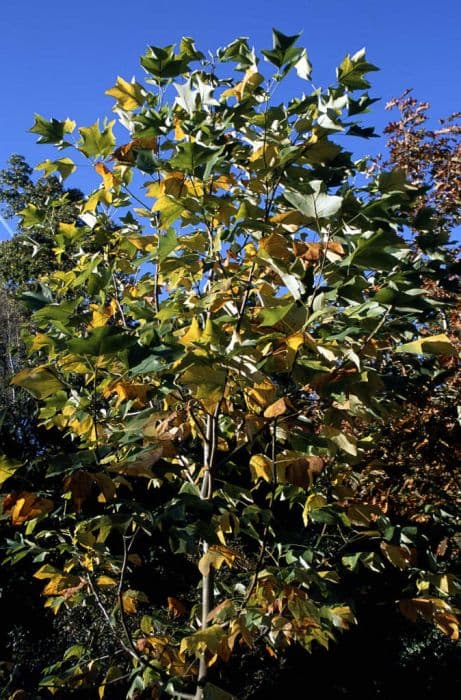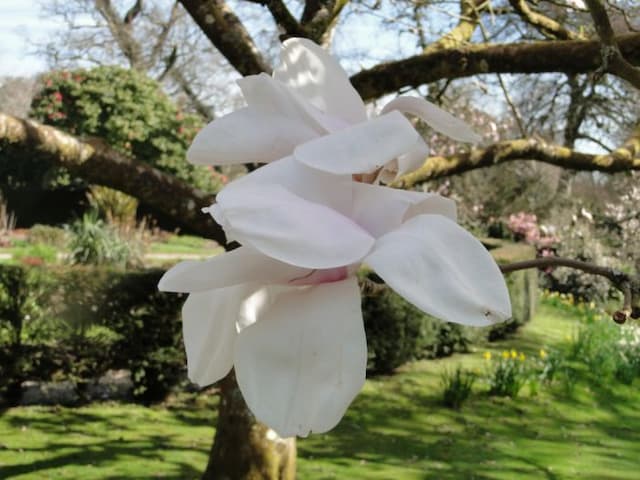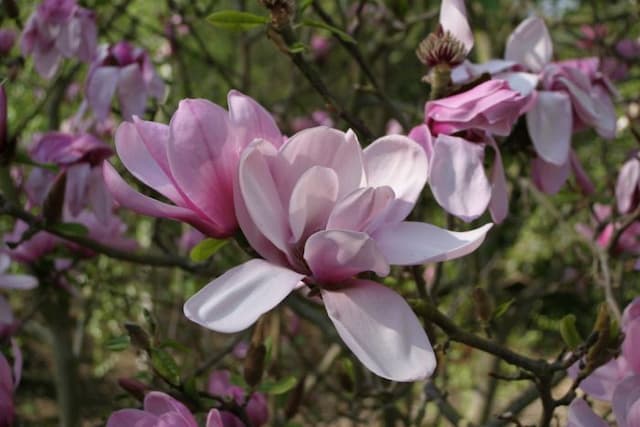Saucer Magnolia Magnolia × soulangeana 'Alba Superba'

ABOUT
Magnolia × soulangeana 'Alba Superba' is a captivating plant known commonly as the saucer magnolia. It is notable for its spectacular floral display. The flowers are large and showy with a saucer-like shape, hence the common name. These blooms exhibit a creamy white color that is often imbued with a subtle pink blush, particularly at the base of the petals. The petals are broad and rounded, giving the flowers a lush, full appearance. The leaves of the saucer magnolia are equally attractive, emerging a soft green color and providing a perfect backdrop to the magnificence of the blooming spectacle. They are typically elongated with a smooth margin. Before the leaves fully develop, the flowers make their striking appearance, heralding the arrival of spring and drawing the admiration of onlookers. The overall form of the saucer magnolia is notably elegant, with a branching structure that provides an open, spreading canopy. This contributes to the plant's visual impact in the landscape, allowing the sumptuous flowers room to showcase their beauty. This magnolia cultivar, with its superb white blossoms, stands as a classic choice for anyone looking to add a touch of serene grandeur to their garden display.
About this plant
 Names
NamesFamily
Magnoliaceae
Synonyms
Saucer Magnolia, Tulip Magnolia, Chinese Magnolia, Japanese Magnolia
Common names
Magnolia × soulangeana 'Alba Superba'.
 Toxicity
ToxicityTo humans
The Magnolia × soulangeana 'Alba Superba', commonly known as Saucer Magnolia, is not considered toxic to humans. There are no widespread reports of poisoning or adverse health effects from ingesting or handling parts of this plant. Therefore, encountering this plant typically doesn't pose a risk of toxicity for humans.
To pets
The Saucer Magnolia is also not recognized as a toxic plant to pets, including cats and dogs. It is generally considered safe, and there is no significant evidence suggesting that ingestion of its parts causes poisoning or health issues in pets. However, as with any non-food plant material, ingestion in large quantities could potentially lead to gastrointestinal upset in some pets due to the foreign material, not because of specific toxins.
 Characteristics
CharacteristicsLife cycle
Perennials
Foliage type
Deciduous
Color of leaves
Green
Flower color
White
Height
20 feet (6 meters)
Spread
25 feet (7.6 meters)
Plant type
Tree
Hardiness zones
5
Native area
Asia
Benefits
 General Benefits
General Benefits- Ornamental Appeal: Magnolia × soulangeana 'Alba Superba', commonly known as Saucer Magnolia, has large, showy white flowers that bloom in early spring, providing a visually stunning display in gardens and landscapes.
- Shade Provision: Once mature, the Saucer Magnolia provides shade with its broad, dense canopy, making it useful for outdoor comfort and as a shelter for underplantings.
- Habitat for Wildlife: The flowers of the Saucer Magnolia can attract pollinators such as bees, providing a source of nectar during the blooming season.
- Seasonal Interest: This plant offers multi-season interest – blossoming flowers in spring, attractive green foliage in summer, and sometimes a modest display of color in fall.
- Architectural Structure: With its broad shape and sturdy branches, the Saucer Magnolia can add structural form to landscape designs, especially during the winter months when other plants have died back.
- Symbolism and Heritage: The Magnolia family is ancient and has a rich history; they are often considered symbols of purity and nobility, adding a layer of cultural significance to a garden or landscape.
- Privacy Screen: When planted in rows or groups, Saucer Magnolias can create a semi-dense screen that enhances privacy without forming an impenetrable barrier.
- Urban Tolerant: Magnolia × soulangeana 'Alba Superba' can be tolerant of urban pollution and compacted soils, making it a good choice for city landscapes.
 Medical Properties
Medical PropertiesThis plant is not used for medical purposes.
 Air-purifying Qualities
Air-purifying QualitiesThis plant is not specifically known for air purifying qualities.
 Other Uses
Other Uses- Culinary decoration: The petals of the Saucer magnolia can be candied and used as an elegant decoration on cakes and desserts.
- Fabric dyeing: The bark and flowers can be used to make natural dyes for fabrics, yielding various shades depending on the mordant used.
- Photography: The large, dramatic blossoms provide a stunning subject for photographers, particularly as a symbol of spring.
- Art: The Saucer magnolia's flowers and branches are often used as motifs in painting, printmaking, and other visual arts due to their aesthetic appeal.
- Perfumery: Occasionally, the scent from Saucer magnolia flowers may be used in crafting perfumes or scented oils.
- Specialty woodwork: The wood of the Saucer magnolia can be used for making small pieces of furniture or decorative woodcrafts.
- Weddings: The branches and blossoms are popular in floral arrangements and bouquets, particularly for spring weddings.
- Cultural festivals: In some cultures, Saucer magnolia blooms are used during festivals to signify purity and renewal.
- Feng Shui: The tree is planted in gardens and landscapes to attract positive energy according to Feng Shui principles.
- Educational tool: The tree is often used for educational purposes in botany and horticulture to demonstrate hybridization and plant characteristics.
Interesting Facts
 Feng Shui
Feng ShuiThe Saucer Magnolia is not used in Feng Shui practice.
 Zodiac Sign Compitability
Zodiac Sign CompitabilityThe Saucer Magnolia is not used in astrology practice.
 Plant Symbolism
Plant Symbolism- Perseverance and Determination: Magnolia × soulangeana 'Alba Superba', commonly known as Saucer Magnolia, blooms in early spring, often braving erratic weather and cold snaps. Its early bloom symbolizes endurance and the ability to overcome adversity.
- Nobility and Dignity: The grand appearance and stateliness of the Saucer Magnolia's blossoms reflect a sense of aristocracy and a dignified presence, suggesting nobility of character or spirit.
- Feminine Beauty: Saucer Magnolias have large, showy flowers that are delicate and fragrant. This symbolizes an elegant and refined beauty, often associated with femininity.
- Purity and Innocence: The white version of Magnolia × soulangeana, in particular, is often associated with purity and innocence, due to the unblemished and crisp nature of its white flowers.
 Water
WaterThe Saucer Magnolia (Magnolia × soulangeana 'Alba Superba') should be watered deeply, ensuring the water reaches the roots, generally once a week during the growing season. In the absence of rain or in very hot conditions, you may need to water twice weekly. Ensure the plant receives about 1.5 gallons per watering session for a young tree, adjusting for size and weather conditions. During winter, reduce the frequency to accommodate the dormant state of the tree and only water if the soil becomes very dry.
 Light
LightThe Saucer Magnolia thrives in full sun to partial shade. It benefits most from a location where it can receive at least 4 to 6 hours of direct sunlight daily, ideally in the morning with some afternoon shade. Avoid deep shade locations as this can hinder its flowering potential and overall health.
 Temperature
TemperatureThe Saucer Magnolia favors temperate climates and can typically handle temperatures as low as 20°F without severe damage and can survive brief dips even lower as long as the cold is not prolonged. It enjoys a range between 60°F and 70°F for optimal growth but can survive in temperatures up to 90°F, especially when given adequate water during hotter periods.
 Pruning
PruningPruning the Saucer Magnolia is often done to maintain shape and remove any damaged or crossing branches, promoting the overall health of the tree. It is best to prune in late winter or early spring before new growth begins, but after the coldest weather has passed. Minimal pruning is generally necessary, and it should be done annually or as needed.
 Cleaning
CleaningAs needed
 Soil
SoilSaucer Magnolia does best in fertile, well-draining soil with a pH of 5.5 to 6.5. A soil mix with loam, peat moss, and compost is ideal for providing the moisture retention and aeration the tree needs.
 Repotting
RepottingSaucer Magnolia trees are best repotted every 3 to 5 years during their early growth phase. Mature trees seldom need repotting and prefer to grow undisturbed.
 Humidity & Misting
Humidity & MistingSaucer Magnolias tolerate a wide range of humidity levels but do well with average humidity typical of outdoor environments.
 Suitable locations
Suitable locationsIndoor
Ensure large space, bright indirect light.
Outdoor
Plant in partial shade, shelter from strong winds.
Hardiness zone
4-9 USDA
 Life cycle
Life cycleMagnolia × soulangeana 'Alba Superba', commonly known as Saucer Magnolia, starts its life cycle with seed germination, which occurs in spring after stratification. The seedling stage involves the development of primary roots and shoots from these seeds. As the plant enters the vegetative stage, it develops a sturdy trunk and branches, along with characteristic large, dark green leaves. The next significant stage is the flowering period where, typically in early spring before the leaves appear, the Saucer Magnolia produces large, white tepals that are a hallmark of this cultivar. After pollination, usually by beetles which are attracted to the flowers, the plant produces aggregate fruit with seeds that, once mature, are dispersed to start a new generation. The mature Saucer Magnolia then enters a cycle of annual growth, flowering, and seed production, with a life span that can extend over many decades with proper care and growing conditions.
 Propogation
PropogationPropogation time
Early spring
The most popular method of propagating the Saucer Magnolia (Magnolia × soulangeana 'Alba Superba') is through grafting, which is best performed in late winter or early spring. In this method, a piece of the Saucer Magnolia that includes at least one bud, known as a scion, is attached to a rootstock of another magnolia. The grafting site is carefully wrapped to ensure a secure attachment and to prevent drying out. The grafted plant is then kept under controlled conditions to encourage the scion and rootstock to fuse together, forming a new Saucer Magnolia tree. Grafting is favorable for this magnolia because it ensures the new tree will retain the specific characteristics of the 'Alba Superba' variety.









![Magnolia [Felix Jury]](/_next/image?url=https%3A%2F%2Fplants-admin.emdemapps.com%2Fimages%2Fplants%2F%2Fimages%2F604b61a0b23b7.png&w=640&q=75)